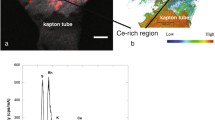Abstract
Several geological formations of the Utah-Colorado mining region mined for uranium ore during and after World War II had been mined earlier for vanadium. Therefore, most miners and millers from that region were exposed to those metals’ ores or tailings at one time or another. Preliminary investigation to determine uranium and vanadium retained in the lungs of a former uranium miner and miller from this region, who died of lung cancer (mesothelioma), showed a high nonuniform distribution of vanadium. This observation led to the hypothesis that the vanadium content in the lungs could be associated with inhaled particles. Further examination of spectra of characteristic X-rays obtained by scanning particle-induced X-ray emission (microPIXE) of an autopsy sample of this lung indicated that vanadium was indeed present in localized sites within the 20-μm spatial resolution of the proton beam. This work points out that the microPIXE-RBS (Rutherford backscattering) test for vanadium can be used for site localization of inhaled particles retained in the lungs. Further studies are in progress to: (i) locate uranium-bearing particles in lung tissues of former uranium miners and millers; and (ii) evaluate the local doses of alpha radiation received from these particles.
Similar content being viewed by others
References
N. P. Singh, M. E. Wrenn, V. E. Archer, and G. Saccomanno, inRadiation Harzards in Mining: Control, Measurement, and Medical Aspects, M. Gomez, ed., American Institute of Mining, Metallurgical and Petroleum Engineers, Inc., NY, 1981, pp. 236–239.
A. S. Paschoa, M. E. Wrenn, N. P. Singh, S. C. Miller, F. W. Bruenger, K. W. Jones, M. Cholewa, A. L. Hanson, and G. Saccomanno, inOccupational Radiation Safety in Mining, H. Stocker, ed., Canadian Nuclear Association, Toronto, 1985, pp. 511–517.
T. C. Chan and M. Lippmann,Am. Ind. Hyg. Assoc. J. 41, 399 (1980).
W. Stahlhofen, inLung Modeling for Inhalation of Radioactive Materials, EUR9384EN, 1984, pp. 39–59.
A. S. Paschoa, M. E. Wrenn, F. W. Bruenger, M. Cholewa, and K. W. Jones, inNuclear Methods in Environmental and Energy Research, J. R. Vogt, ed., OSTI/USDOE, CONF. 840408 (DE84017348), Washington, DC, 1984, pp. 566–573.
A. S. Paschoa, M. E. Wrenn, K. W. Jones, M. Cholewa, and S. M. Carvalho,Nucl. Instr. Meth. Phys. Res. B10/11, 629 (1985).
R. W. Thomas, private communication (1985).
L. M. Trimble and H. H. Duelling,Utah Geol. Mineral Surv. Bull. 113, 1 (1978).
Author information
Authors and Affiliations
Rights and permissions
About this article
Cite this article
Paschoa, A.S., Wrenn, M.E., Singh, N.P. et al. Localization of vanadium-containing particles in the lungs of uranium/vanadium miners. Biol Trace Elem Res 13, 275–282 (1987). https://doi.org/10.1007/BF02796638
Issue Date:
DOI: https://doi.org/10.1007/BF02796638




